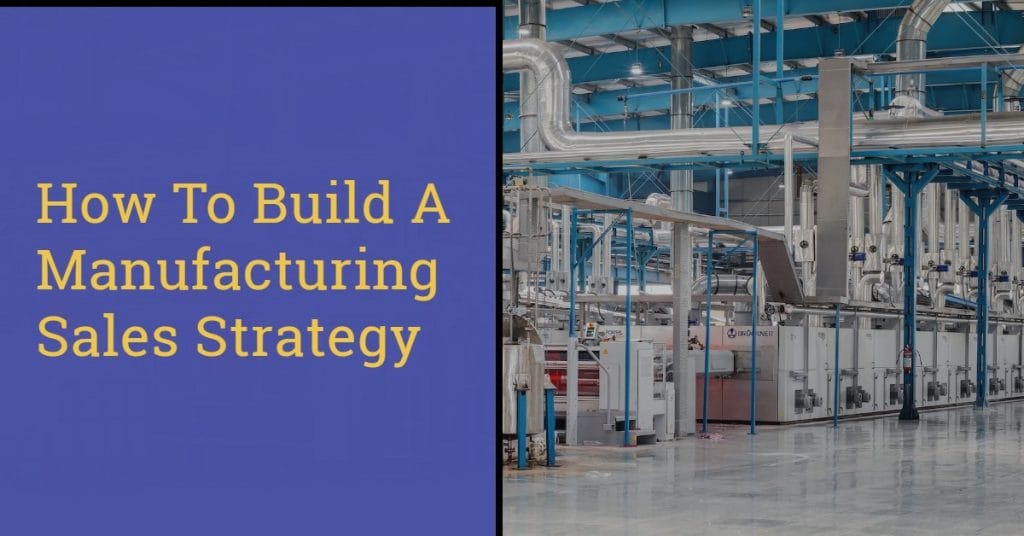Manufacturing sales is anything but simple.
Fortunately, it’s far from impossible. You just need to implement an effective manufacturing sales strategy to meet your company’s revenue goals. We can help you with that!
Once you equip your sales team with the strategy and technology they need to close deals, they’ll do so at a consistent clip. In fact, McKinsey & Company claims that top quartile teams in this regard can deliver four to five times higher sales growth than bottom quartile teams.
In this article, we’ll show you how to join that top quartile by explaining what manufacturing sales is, why it’s beneficial, the challenges that affect sellers in this industry, and eight tips you can use to develop a stellar manufacturing sales strategy for your company. Let’s dive in!
What Is Manufacturing Sales?
Put simply, manufacturing sales is what happens when a manufacturer sells its own products.
The manufacturer in question acquires raw materials or components, assembles them into a product of some kind, and then sells the finished item to the end customer
To do this, the manufacturer has to develop a viable manufacturing sales strategy to help connect with its target audience, build relationships, and close deals. We’ll teach you how to build this kind of strategy. But before we do, let’s cover the challenges you’ll likely face…
Manufacturing Sales Challenges
As mentioned above, manufacturing sales is difficult. Those in this industry have to fight to retain top talent, hold buyers’ attention through complex buying processes and extended sales cycles, and compete in an oversaturated market. Let’s take a closer look at each challenge:
Retaining top talent
First, it’s difficult for many manufacturers to retain their best sales reps.
This has become more true in recent years, as remote work is now commonplace. All-star sellers have many companies they could work for, so competition for their services is intense.
To overcome this challenge, manufacturers need to go above and beyond for their employees. Work to create an atmosphere that your team wants to be a part of.
Complex buying process
Also, buying from manufacturers can be very complex.
Many manufacturers have large product libraries, which can be a pain to sort through. And due to remote working arrangements, it can take longer for buyers to receive approval for purchase.
After all, they can’t always walk down the hall and ask their boss to sign off on a product. Instead, they have to schedule Zoom meetings, scan through email threads, etc.
The solution? Work to simplify the buying process for your customers. You can do this by training your reps to guide prospects to the right products, investing in ecommerce, and more.
Extended sales cycle
Complex buying processes lead to extended sales cycles.
Customers have to determine what they want to buy, who they want to buy it from, and what their budget is. And they still have to complete their normal, everyday duties. It’s a lot.
Rather than trying to shorten your sales cycle, try to improve the customer experience instead. This won’t help your reps close deals faster, but it will help them close deals more consistently. It will also lead to greater customer loyalty and plenty of repeat buyers.
Competitive and saturated market
Finally, there are tons of other companies selling products like yours. Why should a potential customer buy from your brand? You need to give them a legitimate reason.
Maybe you offer better prices. Or a more enjoyable customer experience. Or a killer return policy. Whatever your USP is, make sure it can compete with the many local, international, and online businesses that would love to steal your customers.
The Role of Sales Enablement In Manufacturing Sales
Sales enablement is the process of equipping reps with the resources they need to make sales.
Said resources may include specific software apps, email and call scripts, blog posts and other pieces of content, training modules, and anything else reps can use to boost close rates.
Sales enablement is especially important in the manufacturing industry because it can help increase customer engagement, make it easier to retain skilled talent, improve team collaboration, and even maximize ROI for your company. Let’s talk more about these benefits…
Benefits of Manufacturing Sales Enablement
Sales enablement is key to an effective manufacturing sales strategy. In fact, it’s often difficult for reps to close deals without a strong sales enablement foundation in place. Here’s why:
Increase customer engagement
Your customers crave personalization. If you don’t tailor the buying experience to their individual wants and needs, they’ll take their business to a different manufacturer.
Fortunately, the right tools will help you store custom information for each of your prospects. You can then use this data to personalize the sales collateral you send to customers.
Retain skilled talent
Sales enablement can boost your employee retention rate, too. It makes sense. When reps have the training and resources they need to close deals, they’ll find more success, which will lead to greater job satisfaction. Employees tend to keep jobs that they enjoy doing.
Improve team collaboration
Speaking of retention, companies that prioritize collaboration between employees see a nearly 30% boost in employee satisfaction. Collaboration can also lead to 50% greater productivity.
These stats are important because happy employees will stick around for longer, while productive employees will generate more leads, engage more customers, and close more deals.
Proper sales enablement will allow multiple departments, from marketing to sales to customer service, to collaborate on sales collateral, leading to better outcomes for all.
Maximize ROI
Last but not least, sales enablement will help you maximize ROI for your manufacturing sales team. It’s almost inevitable. When you increase customer engagement, retain your best sellers, and improve collaboration across departments, revenue is more likely to rise.
8 Tips to Develop an Effective Manufacturing Sales Strategy
An effective manufacturing sales strategy will do wonders for your business—especially if you incorporate sales enablement. But how do you actually design and implement this kind of plan?
Here’s an eight-step process you can use to increase manufacturing sales ASAP:
1. Identify your ideal target market
Who do you want to sell to? You need to have a deep understanding of these people, which you can get through market research, competitor analysis, and by interviewing current customers. Once you gather data, assemble it into a buyer persona. Your personas should include details about your audience’s age, gender, salary, the industry they work in, and the needs they have.
2. Set clear sales goals
Next, decide what you want to achieve. Maybe you want to increase market share. Or expand into a different industry. Or maximize profit for every sale you make. Whatever your goals are, make sure they’re SMART: specific, measurable, attainable, realistic, and time-bound. SMART goals will help you set objectives that serve your business, not the other way around.
3. Select a sales approach
How will you reach potential customers? You can use an outbound sales approach, where reps make in-person visits, cold calls, etc. to engage prospects. You can also use an inbound sales approach, where reps (or marketing pros) create content to attract prospects to them. Both are viable manufacturing sales strategies, though manufacturers tend to focus on outbound sales.
4. Align your teams
A whopping 90% of sales and marketing professionals believe their company’s sales and marketing teams are misaligned. This often leads to mixed-messaging, low sales, and a poor reputation in the marketplace. To align your manufacturing sales and marketing efforts, open communication between teams, create shared goals, and integrate each team’s tech stack.
5. Prioritize sales enablement
Like we mentioned earlier, sales enablement will help you boost customer engagement, lower employee turnover, improve team collaboration, and maximize ROI. That’s why you should prioritize it in your manufacturing sales strategy. Take time to develop effective training programs, must-read sales collateral, and the like to ensure more prospects become customers.
6. Implement an aftermarket sales strategy
Research finds that a proper aftermarket sales strategy can increase cash flow, reduce risk, and improve the customer experience. Of course, wanting to sell aftermarket parts and actually do it are two different things. To increase follow-up sales within your manufacturing sales strategy, consider your market and competition. Then work to develop greater loyalty with customers.
7. Utilize technology and automation
There’s no shortage of technology you can use to make manufacturing sales. The trick is to choose the right tool for the job. In many cases, the “right tool” will include automation capabilities. That way you can automatically add prospects to your CRM. Or manage inventory and process orders. Or send follow-up communications. Choose tools that have these features.
8. Monitor and optimize your sales process
Finally, you must track your manufacturing sales strategy. Is it working? If so, implement similar techniques. If not, look for ways to optimize your approach. The only way to reliably improve is to look at the data and iterate based on your findings. Then repeat the process.
SPOTIO Elevates Your Manufacturing Sales Strategy
Manufacturing sales is often difficult. But with a solid plan, the right tools, and a healthy dose of grit and fortitude, you can increase sales for your manufacturing company.
Speaking of the right tools, give SPOTIO a try. Doing so will give you access to features you can use to aid your outbound sales efforts. Some of these features include territory mapping, lead generation, route planning, sales tracking, task automation, and custom reporting solutions.
Sign up for a free demo of SPOTIO today to experience the power of our platform for yourself!




